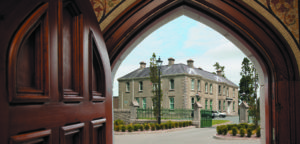RE-DEDICATION MASS – ST. PATRICK’S, DUNDALK
SATURDAY NOVEMBER 30, 1997
HOMILY BY CARDINAL SEÁN BRADY
Local history tells us that in 1748 an Army officer was so impressed by the fidelity and devotion of the Catholics of Dundalk to the Mass that he persuaded the Earl of Clanbrassil to give them a site for a permanent church. He had seen them at Mass gathered in and around an old shed one Sunday morning on St. Helena’s Quay. The result was that the old St. Patrick’s was built in 1750 in Chapel Street. It served its purpose for almost a century.
With the achievement of Catholic emancipation the need for a larger church became evident. Doctor Matthew McCann secured the site in 1834. In 1845 its Trustees were listed as: Archbishop Crolly, Father Coyne, Parish Priest, James Carroll, merchant of Earl Street and Nicholas Martin, merchant of Clanbrassil Street. Dr. Matthew McCann engaged Mr. John Duff, Newry, as architect and the foundations had just been laid when Dr. McCann was called to his eternal reward early in 1837. Mr. Duff was the original architect of St. Patrick’s Cathedral, Armagh also.
We know that owing to Dr. McCann’s illness slow progress was made with the work during the years 1835 and 1836. The new Parish Priest was Fr. John Coyne formerly Parish Priest of Tandragee. The work really got underway in 1837. On New Year’s Day a Committee of ninety people was appointed to speed it up. A Building Committee of twenty-six was chosen to see to all matters connected with the building. Mr. Duff chose to use Newry granite and to build the church in the Gothic style. St. Patrick’s was built by direct labour with two members of the Building Committee in strict rotation, undertaking the duty of supervising the work, ordering the materials, employing workmen, paying wages and ensuring that the decisions of the Committee were carried out.
All of these were busy people, with their own jobs to look after. We are told that not one of them ever failed to do his allotted part of the work. It is a tremendous tribute to their self-sacrifice and generosity. St. Patrick’s was in use in 1842 but wasn’t considered finished until 1847. It was built at a cost of £25,000 and without any outside help. This huge sum, huge for those Famine days, was realised by weekly contributions from the parishioners. St. Patrick’s stands as a noble testimony to their strong faith and immense generosity.
Father Coyne’s other great contribution to Dundalk was the introduction of the Sisters of Mercy. Their contribution to the educational and health care life of this town has been enormous.
Dr. Coyne died in early February 1848. Before his death he had the great consolation of seeing this beautiful Church completed. Daniel O’Connell described him as a “most learned, respectable, and exemplary clergyman”. His mortal remains rest here before the altar and a mural tablet to his memory may be seen on the right wall.
St. Patrick’s Dundalk was one of thirteen churches built in the diocese of Armagh during the 1840s. Here in County Louth the Church of St. Mary, Kilsaran, was built in 1840 and the Church of the Assumption, Sandpit, Termonfechin parish, was built in 1846. In a publication called: “Centenary Record of St. Patrick’s Dundalk” the author makes this comment:
“By adding his own valuable quota each Administrator, with the able assistance of the Parochial Committee, has contributed to render St. Patrick’s what it is today, one of the finest churches in Ireland”.
The present Administrator, Father Gerry Tremer, and the other priests, and the Parochial Committee, continue that fine tradition. I congratulate them on planning and carrying out an extensive programme of events to commemorate this 150th anniversary. I congratulate Father Murtagh on his excellent history published earlier this year: ‘St. Patrick’s Dundalk, an Anniversary Account’. I thank and congratulate all who were involved in the renovations and repairs undertaken in the Church itself. They not only render St. Patrick’s one of the finest churches in Ireland but will ensure that it remains such for a long time to come. The improved lighting will enable us all to see more clearly and admire the splendid mosaics which adorn the walls of the sanctuary. There are many features of the work done such as the raised sanctuary, the new altar, ambo and chair which will definitely contribute to and enhance the liturgy.
So tonight a new chapter in the history of St. Patrick’s, Dundalk, opens with the blessing and dedication of this lovely new altar. We give thanks to God for the people who put St. Patrick’s here in the first place and who have kept it in existence over the last 150 years. We rejoice to see so many native sons and daughters present on this happy occasion. We give thanks to God for all who have celebrated Mass here over the last 150 years and again it is good to see so many of those present, especially Cardinal Daly. We give thanks for all who have played an active part in the ceremonies celebrated here over these 150 years, the choir, the organist, the collectors, the stewards and many other people, especially the Sacristan, who has completed fifty years of wholehearted service and is about to retire. We wish him many blessings in his retirement.
We praise God for all the parish groups and organisations involved in the various processions here this evening. As the altar is dedicated we are reminded it is the place where people offer their lives and their gifts. Where they unfold their good intentions and pour out their prayers. So I hope that this altar really will prove to be that sort of place for all who enter St. Patrick’s who come in here whether it is simply to say a prayer or to attend Mass, whether they come in joy or in sorrow in their youth or in their old age.
The altar will be anointed with oil, the oil of Chrism. Oil is one of God’s most powerful gifts. In many countries it is used as food. It gives strength and nourishment. One of the prayers this evening asks that we may find nourishment and strength as we stand at the Lord’s table. Oil is a great source of healing, from wounds, from pain, from illness. Friends of Christ who gather around the altar which has been anointed with oil, cast their burdens and their cares upon the Lord and take up their journey restored. The altar is a visible sign of Christ who offered himself for the life of the world. He offers himself to each one of us in Holy Communion to be our nourishment and food on the journey of life – that we may have the strength to do what he tells us to do.
The Gospel we have just heard is taken from words spoken by Jesus in the temple. It says: In the daytime he would be in the temple teaching but he would spend the nights on the hills called the Mount of Olives (presumably in prayer), and from early morning the people would gather round him in the temple to listen. Jesus spent his time in the temple teaching. He prepared for that teaching by prayer. The people listened to him. There is a lesson there for all of us, especially for those of us who preach.
Jesus was well aware of what was going around him. Rich and poor came to hear him. He saw them putting their offerings into the treasury. It was then that he was moved to praise the poverty-stricken widow who had put in all she had to live on. Then Jesus goes on to speak of the coming of the Son of Man. He will come again in a cloud with power and great glory. His first coming was without power and glory in a stable in Bethlehem. In this passage the Gospels speak of men dying of fear as they await what menaces the world. Jesus urges his disciples to stand erect and hold their heads high because their liberation is near at hand.
There is a third coming of the Son of Man. It is taking place here and now. Now he comes in word and sacrament and is really present in our midst. He comes in word, calling on us to believe in him, not to put our trust in anything else. Not to put our trust in the false Gods of power or wealth or popularity or success. He comes in his Word now to warn us to be on our guard and not to allow ourselves to become pre-occupied with too much feasting and drinking, nor with the worries of this life. The writer of the Gospel doesn’t want us to be caught unprepared when the day of the Son of Man could be sprung on us like a trap and catch us off our guard. So he tells us to be on the alert and to pray that we will have the strength to go safely through all those things that will happen and to stand before the Son of Man.
So as St. Patrick’s Church begins it 151st Advent Season the message of Advent is and always will be the same. To pray that we will have the strength to go through safely all that will happen, and have the wisdom to hear the Son of Man speaking to us in his Word and beckoning us to follow him no matter what the cost. He is inviting us to believe in him, to believe that he is present in his Words and in his Sacraments and in our lives and in our neighbours. If we see him and serve him there, well we may have no fear. Then we can confidently stand and hold our head on the last day for he will be coming to set us free.
Jesus told us that he came into the history of the world not to bring peace but to bring a sword. Christmas is not a feast of display and show-off. It is feast of the powerlessness of the love of God, a love which only through death will reveal its super power. The time that intervenes between the first Christmas and the last Judgement is nothing else than the time given to people to decide whether to believe in Jesus or not. He came not to judge the world but to save it. Those who reject him and do not accept his message have one who will judge them. The words that he has spoken will be their judge on the last day. Jesus came into the world as light so that everyone who believes in him should not remain in the darkness. May St. Patrick’s continue to reflect that light ever more brightly. May everyone who comes in here be helped to accept the message of Jesus so that they may have life and have it to the full. May Mary, who is honoured here so lovingly and so tenderly, especially in the month of May, watch over and protect the people of Dundalk.
AMEN



You must be logged in to post a comment.